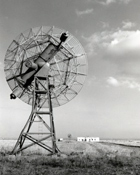Institute for Telecommunication Sciences / About ITS / Resources / Table Mountain / History / Chapter 5: Aeronomy Laboratory
Chapter 5: Aeronomy Laboratory
The Aeronomy Laboratory conducts studies of the physical, chemical and electrical properties in the "upper" atmosphere. It is not possible or useful to specify exactly either the lower or the upper portions of the atmosphere that delineate the domain of aeronomy, but about 40 kilometers (just above the ozone layer) can be taken as a convenient lower boundary and 64,000 kilometers (the approximate outer edge of the earth's magnetic field) for the upper boundary.
In this new science (the word aeronomy was invented in 1945) studies include direct measurements from rockets and satellites, indirect measurements of the upper atmosphere from ground stations, simulation of atmospheric conditions in laboratory experiments, and the synthesis of these observational and experimental "facts" by theoretical evaluations. A satellite signal receiving station located at the Table Mountain Field Site is a key unit in the rocket and satellite program. A radio-telescope at the Table Mountain location is used to obtain information about the electromagnetic environment of the earth and the propagation media.
Beacon Satellite Experiments (BUILDING T-2)
In the north portion of this building the Aeronomy Laboratory has installed a special-purpose signal analysis receiving system which constitutes one of four ground stations studying radio transmissions from the Ionospheric Beacon experiments on satellites OGO-I and OGO-III. The 28' antenna to the west of the building receives transmissions on 360 MHz; the antenna to the east receives the signals transmitted on 40 MHz. These antennas, originally used for radio astronomy studies of the ionosphere, were refitted for this task. By comparison of signal characteristics as received on the two frequencies, both ionospheric and total integrated electron content along the line-of-sight from ground station to satellite can be deduced. Techniques include differential Doppler, differential Faraday rotation, and group delay measurements. The highly elliptical orbits of these satellites permit, in principle, measurements out to the apogee distances of about 150,000 km, but spacecraft difficulties have prevented us from realizing the full potential of the experiment.
The south room of the building contains equipment for Faraday rotation measurements to deduce details of ionospheric electron content using transmission from satellites Beacon Explorer-B and -C. Routine observations on this program were only recently terminated.
Radio Astronomy (Radio-Telescope)
The Aeronomy Laboratory has constructed a large radio-telescope which operates on 10 MHz at the Table Mountain field site. This array is of the "Mill's Tee" type and as such uses the modern techniques of aperture synthesis in order to achieve the desired resolution of a few degrees. The data is recorded with digital equipment in a form compatible with computer analysis. The computer is capable of combining many data samples to produce a map of the radio sky.
The telescope yields detailed information on the nature of the extra-terrestrial radio sources as seen in the HF region around 10 MHz. For example, information is obtained on the following: the sporadic radio emissions of Jupiter; the nature and extent of regions of ionized hydrogen gas in the plane of our galaxy; the structure and extent of our galaxy; and on the physical nature of certain extra-galactic "radio stars." In addition, since the signals from these sources must pass through the earth's ionosphere, and are there refracted and partially absorbed, useful ionospheric information is obtained.
The work is concerned with both the nature of the electromagnetic environment of the earth and with the nature of the propagation media, both in space and in the ionosphere. It will be of use to astrophysicists in formulating cosmological theories; in understanding the physical nature of our own galaxy; and in determining the physical processes at play in the "radio stars." The ionospheric information obtained will be useful to those working in propagation who are concerned with absorption in the same manner that riometer data is used by them, since the telescope can be regarded as a riometer which looks at very small angular regions. In addition, the refraction data will be useful to those concerned with the structure of the ionosphere and those concerned with tracking space vehicles.
Several rather interesting astrophysical observations have been made which include: (1) Measurements of the flux densities (intensities) of several discrete radio sources (radio stars) at the relatively low frequency of 10 MHz. (2) Observations of the synoptic characteristics of the intense decametric radiation from the planet Jupiter at 8.9 ad 10 MHz. (3) Measurements of the integrated brightness of the sky at 10 MHz. A map of the northern sky at 10 MHz with an angular resolution of 10º x 30º is being made. Simultaneous observations of type III solar bursts at 8.9, 10, 13, 18, and 36 MHz have been made in cooperation with the University of Colorado, Department of Astro-Geophysics, and are being analyzed.





